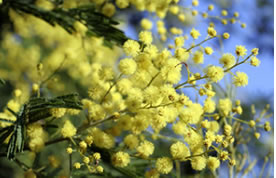The Importance Of Our Trees To Bees
A local beekeeper writes that we need them as a pollen source
|
Here in W4 we have so many different pollen sources and it is not really the flowers in our gardens. They are good, but very limited in what they can produce in terms of volume and we often spray them.
A tree, on the other hand, with its spreading canopy-when they are not pruned to nothing- provides a huge amount of (unsprayed) food, pollens and nectars, and these make for healthy bees. Here in Grove Park we have Lime trees, Acacias and False Acacias, the Horse Chestnuts of Hartington Road, and the two remaining Sweet Chestnuts in the Poly Tec grounds. We also have the magnificent London Planes at the end of the Strand on the Green towpath; planes are members of the Sycamore family and are a good source of forage.

Acacia tree
North of the A4 we have the majestic planes of Barrowgate Road, and all the Limes and Cherries- useful ones- on Turnham Green. I am grateful that the Council has put the needs of pollinators on their radar now. They have planted the wild flowers on the west margin of Turnham Green. But the bees must have a little laugh about it. 'Look up', they would say " These brilliant trees are our real source of food".
It is often only after the event that we realise we have lost something precious. While we have it, we do not really value it. So I want to raise awareness of the fantastic heritage of trees we have here in Chiswick before they are lost, not just to us but to local bees who depend on them.
Unfortunately, not everyone agrees. So many beautiful healthy trees have been destroyed in the last few years, despite the Council's claim that they only remove dead, dying, or dangerous trees. A magnificent Willow on Strand on the Green was drilled and poisoned last year and chopped down. It was not because it was blocking the towpath, because the stump has been left still blocking it for the past 18 months. And it cannot have been because it was damaging drains. A tree that has reached that size and not caused problems will not suddenly start damaging drains.
Two other trees, one in Grove Park Gardens and one in Grove Park road were marked for destruction -They are now a shadow of their former selves but so far are still with us. And yet, while healthy trees have been destroyed, there is an Acacia at the east end of Grove Park Gardens, the central one of three, which has been left for years with what is probably very serious honey fungus. Even an amateur could see the fungus outgrowth on the tree.
I recently saw branches removed from a healthy tree in a way that did not allow dieback space- this will weaken the trunk in time. And cut surfaces should be painted to prevent infection entering. A beautiful mature willow was recently removed by Turnham Green station- it lay on the ground for weeks, yet I saw no visible signs of disease. From what I have seen Ealing borough values its trees and they are not reduced to gaunt spectacles.
Inspired by a soap making class at my Bee Keeping club I have now spent nearly two years refining a recipe for soap and developed a number of cosmetic balms made using beeswax sourced from local beehives. I hope to have them on sale soon, so watch this space.
Annette Duckworth
May 15, 2015